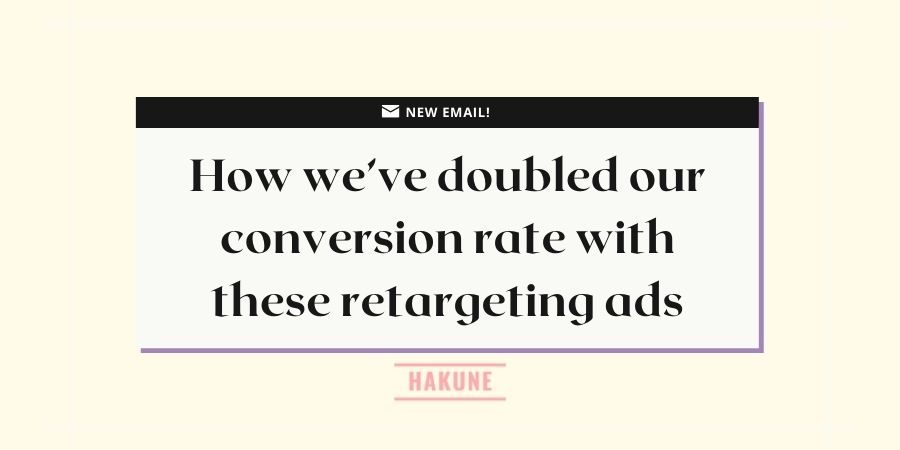The Method Episode #24

New Retargeting Ads Method That Will Double Your Conversions
It’s no secret that Facebook ads aren’t what they used to be.
In the last year alone, cost per click is up 50%, and the cost per impression is up 25%. This means more money in Facebook’s pockets and less in yours.
We’ve been navigating this problem at K&J Growth, our performance marketing agency, for a while now, and we’ve just made another breakthrough. This week, we’ve increased our lead conversion rate by 108% with remarketing ads.
Remarketing is the act of running ads targeted toward past visitors to your site.
You’ll have seen these on Facebook many times. They’re those ads on your feed saying that ‘you must have forgotten to complete your order, hurry back for blah blah blah‘. Or maybe you don’t recall them at all – which is precisely the problem.
For forever, retargeting ads have been the most profitable on Facebook – in our experience, they outperform cold audience ads by anywhere from 10 – 20x. But most brands know that now, so everyone is running them, and they all look the same.
So this is what we’re doing with our retargeting ads to stand out.
Your Target
First, you’ve got to decide who you’re retargeting. At K&J, we’re retargeting people who’ve visited our sales page but not taken any further action, i.e. they haven’t clicked our ‘contact us’ button.
Your Creative
Once you know where you’re retargeting your audience from, you’ve got to create ads that match your website experience. We use the same Headline, Subtitle and Imagery from our sales page.
• Note that most brands use generic copy and imagery for retargeting ads that don’t match their website. So they blend in with every other retargeting ad on FB – Mistake #1
Your Offer
Now that you’ve got someone’s attention because your ad stands out in their feed, and they recall who you are as they’ve been to your website. It’s time to make an offer – but don’t just say, ‘please come back to our website we want your money‘ – Mistake #2
Give more. At K&J, we direct people back to a case study on our website to further prove the value we can create for a client.
You could offer a free trial, money-back guarantee or a video testimony from your customers.
Key takeaway: Make your retargeting ads stand out by using copy and imagery that matches your on-site page experience and offer a little more to bring people back to your website.

The Fridge Test – How To Know Find Your Metrics Matter
There are only two types of business owners, those who love metrics and those who pretend they don’t exist.
I sit firmly in the ‘those who love them‘ camp, so the last three weeks have been uncomfortable.
We just changed CRMs at our gym, and it’s taken our team a while to get up to speed with the new system. So, I haven’t received a single business report for three weeks, and well, I’m feeling a little lost.
This reminds me of when I was a university student, checking the fridge for food every 5 minutes even though I knew it was empty. I’ve probably opened my business report docs 20 times just to stare at a blank page over the past three weeks.

This helped me realise only a few metrics at our gym truly matter. I usually track about 20 different numbers from revenue to leads to membership cancellations and so on. But there are only three I’ve been missing.
Revenue, Paying Members and Churn. When they’re good, I know the gym is good. All the rest are surplus to requirements.
So I think the lesson here is that if you want to know which metrics truly matter, start cutting. Remove them one by one from your reports – until you find yourself checking the fridge, so to speak.
And a supplementary question might be: If this metric grows or declines, does it indicate whether my business is doing well?
“Not everything that counts can be counted, and not everything that can be counted counts.”
~ Albert Einstein
Where We’re Learning
• Kool Aid Factory-> Epic blog we found full of zines on business management principles
• Business Metrics Tweet -> Explanation of business metrics worth considering for small business owners

Building Redundancy: Why You Need Room To Deal With Chaos
In episode #22, we talked about creating space in your day so you have time to think and ideate to foster innovation for your business.
There’s a second advantage to creating space or phrased differently this week, baking in redundancy.
Business is a balance of chaos and order. To deal with chaos, i.e. unexpected negative surprises (like just this week, I got told we’re getting a**h*led out of our lease), you will need slack in your systems.
If your team, facilities, and bank balance are maxed out, and extra chaos arises, something or someone will break.
Redundancy has a cost that many of us are scared to pay. We all know those micro-managers that hate seeing their staff standstill for more than two minutes. Those micro-managers see stillness as wasted money, so they keep pushing for more from their team. But then the unexpected pops up, and there’s no capacity to deal with it. This costs the business far more than those moments of stillness in the long run.
Ants understand this well. Most of the time, about half a colony sits around doing nothing. Why? In nature, extreme events (chaos) happen regularly. If a flash flood destroys part of the colony, the reserve ants are ready to respond.
Redundancy increases your ability to adapt and evolve to changing conditions and recover from or capitalise on extreme events.
Not being able to deal with chaos is the biggest risk your business faces. Our earlier mentioned lease situation doesn’t bother me because we’ve baked redundancy into our business – we have the slack in our systems to adapt and overcome.


